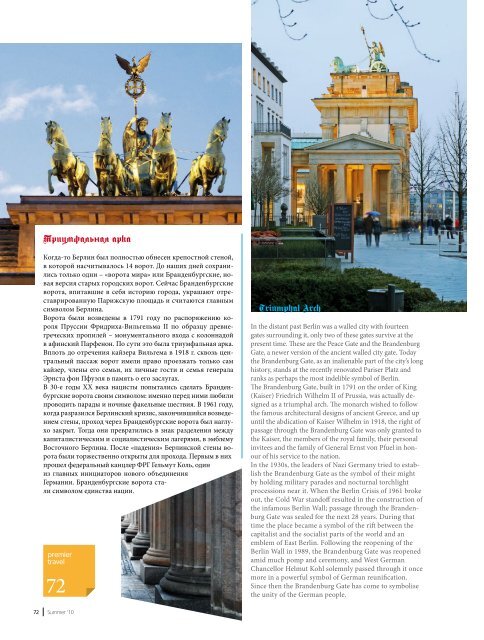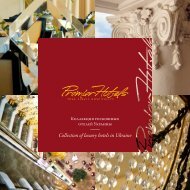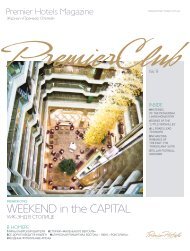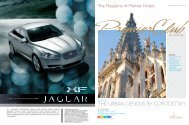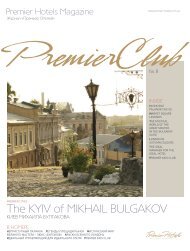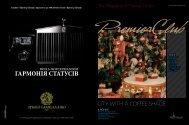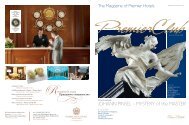YalTa: CriMea's PreMiere resorT
YalTa: CriMea's PreMiere resorT
YalTa: CriMea's PreMiere resorT
You also want an ePaper? Increase the reach of your titles
YUMPU automatically turns print PDFs into web optimized ePapers that Google loves.
Триумфальная арка<br />
Когда-то Берлин был полностью обнесен крепостной стеной,<br />
в которой насчитывалось 14 ворот. До наших дней сохранились<br />
только одни – «ворота мира» или Бранденбургские, новая<br />
версия старых городских ворот. Сейчас Бранденбургские<br />
ворота, впитавшие в себя историю города, украшают отреставрированную<br />
Парижскую площадь и считаются главным<br />
символом Берлина.<br />
Ворота были возведены в 1791 году по распоряжению короля<br />
Пруссии Фридриха-Вильгельма II по образцу древнегреческих<br />
пропилей – монументального входа с колоннадой<br />
в афинский Парфенон. По сути это была триумфальная арка.<br />
Вплоть до отречения кайзера Вильгема в 1918 г. сквозь центральный<br />
пассаж ворот имели право проезжать только сам<br />
кайзер, члены его семьи, их личные гости и семья генерала<br />
Эрнста фон Пфуэля в память о его заслугах.<br />
В 30-е годы XX века нацисты попытались сделать Бранденбургские<br />
ворота своим символом: именно перед ними любили<br />
проводить парады и ночные факельные шествия. В 1961 году,<br />
когда разразился Берлинский кризис, закончившийся возведением<br />
стены, проход через Бранденбургские ворота был наглухо<br />
закрыт. Тогда они превратились в знак разделения между<br />
капиталистическим и социалистическим лагерями, в эмблему<br />
Восточного Берлина. После «падения» Берлинской стены ворота<br />
были торжественно открыты для прохода. Первым в них<br />
прошел федеральный канцлер ФРГ Гельмут Коль, один<br />
из главных инициаторов нового объединения<br />
Германии. Бранденбургские ворота стали<br />
символом единства нации.<br />
premier<br />
travel<br />
72<br />
Triumphal Arch<br />
In the distant past Berlin was a walled city with fourteen<br />
gates surrounding it, only two of these gates survive at the<br />
present time. These are the Peace Gate and the Brandenburg<br />
Gate, a newer version of the ancient walled city gate. Today<br />
the Brandenburg Gate, as an inalienable part of the city’s long<br />
history, stands at the recently renovated Pariser Platz and<br />
ranks as perhaps the most indelible symbol of Berlin.<br />
The Brandenburg Gate, built in 1791 on the order of King<br />
(Kaiser) Friedrich Wilhelm II of Prussia, was actually designed<br />
as a triumphal arch. The monarch wished to follow<br />
the famous architectural designs of ancient Greece, and up<br />
until the abdication of Kaiser Wilhelm in 1918, the right of<br />
passage through the Brandenburg Gate was only granted to<br />
the Kaiser, the members of the royal family, their personal<br />
invitees and the family of General Ernst von Pfuel in honour<br />
of his service to the nation.<br />
In the 1930s, the leaders of Nazi Germany tried to establish<br />
the Brandenburg Gate as the symbol of their might<br />
by holding military parades and nocturnal torchlight<br />
processions near it. When the Berlin Crisis of 1961 broke<br />
out, the Cold War standoff resulted in the construction of<br />
the infamous Berlin Wall; passage through the Brandenburg<br />
Gate was sealed for the next 28 years. During that<br />
time the place became a symbol of the rift between the<br />
capitalist and the socialist parts of the world and an<br />
emblem of East Berlin. Following the reopening of the<br />
Berlin Wall in 1989, the Brandenburg Gate was reopened<br />
amid much pomp and ceremony, and West German<br />
Chancellor Helmut Kohl solemnly passed through it once<br />
more in a powerful symbol of German reunification.<br />
Since then the Brandenburg Gate has come to symbolise<br />
the unity of the German people.<br />
72<br />
Summer ‘10


